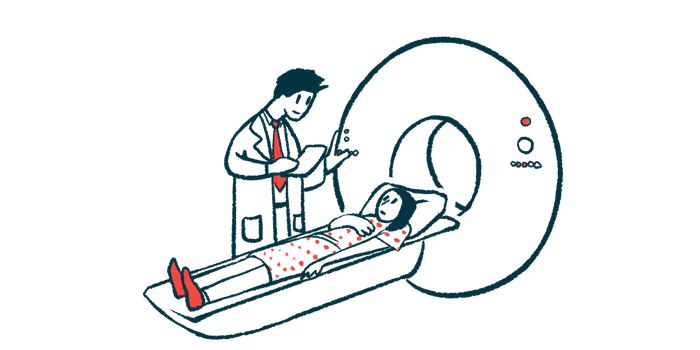Brain Age Gap on MRI May Predict Disability in NMOSD, Analysis Finds
Scans show significant difference in patients' calendar age and brain age
Written by |

Brain age gap (BAG) — the difference between calendar age and predicted brain age as determined by MRI scans — was significant in adults with neuromyelitis optica spectrum disorder (NMOSD), and may predict disability in patients, a study found.
The BAG was even greater in people with the related condition relapse-remitting multiple sclerosis (RRMS), the most common type of MS.
“Higher disability and advanced atrophy [brain shrinkage] were associated with a larger BAG in both NMOSD and RRMS,” the researchers wrote.
According to the team, the brain age gap was a predictive biomarker for disability worsening in both neurological disorders.
The MRI study, “Brain age gap in neuromyelitis optica spectrum disorders and multiple sclerosis,” was published in the Journal of Neurology, Neurosurgery and Psychiatry.
Investigating brain age in NMOSD
In most NMOSD cases, patients have elevated levels of an antibody called anti-aquaporin-4 (AQP4-IgG), which targets proteins found on nervous system support cells called astrocytes, known for their star shape.
Immune attacks in NMOSD are known to damage myelin, a protective fatty coating on nerve fibers.
MS is another autoimmune disease also marked by myelin damage. In comparison, NMOSD mainly affects only the optic nerve and spinal cord, whereas MS typically impacts multiple areas of the brain as well as the spinal cord and optic nerve.
Although NMOSD attacks are generally more severe than those in multiple sclerosis, MS can start with periods of relapse and remission like NMOSD and then develop into the progressive disease. Further, people with MS are more likely to experience progressive cognitive decline.
Despite these differences, changes in the nervous system due to myelin damage appear similar across the disorders.
Age is a risk factor in both conditions, but aging does not affect people in the same way. As such, according to researchers, new biomarkers of aging may help explain some of these individual differences and shed light on age-related disease processes.
One key measure is brain age, or a brain’s predicted biological age — which can differ from calendar age due to diseases affecting the brain and spinal cord.
Using MRI scans and computer-based methods such as deep learning, scans from a patient can be compared with those from a range of healthy individuals to estimate the person’s brain age. This may provide a more detailed understanding of the neurological impact of NMOSD and MS.
Although the brain age gap (BAG) — the variation between the calendar age and predicted age of a person’s brain — has been investigated in MS, it has not been studied in NMOSD.
Now, researchers in China used a deep-learning brain age model to examine BAG’s utility as a biomarker to predict disease worsening in patients with both disorders.
The newly developed model “was able to estimate BAG from three-dimensional structural MRI scans and is robust across multiple centres and multiple scanners,” the team wrote.
First, the deep-learning model was trained using the MRI scans, acquired from publicly available databases, of 9,794 healthy individuals. Then, the team enrolled 199 NMOSD patients, 200 patients with RRMS, and 269 age- and sex-matched healthy controls (HCs).
At the study’s start (baseline), those with NMOSD were older and had a longer disease duration than the RRMS patients. The NMOSD patients also experienced less severe disability, as assessed with the expanded disability status scale (EDSS), compared with those with RRMS.
Follow-up lasted a mean of 5.2 years for the RRMS patients and 5.8 years for those with NMOSD. During that time, 31 NMOSD and 42 RRMS patients experienced EDSS worsening.
MRI scans revealed that both patient groups had lower overall brain volumes than controls. Normalized brain volume values showed less shrinkage (atrophy) in NMOSD and a lower volume of lesions than in RRMS.
Differences between NMOSD, RRMS
Baseline differences in BAG between patients and controls were relatively consistent across chronological ages. However, while NMOSD patients had a significantly higher brain age gap than controls (4.6 years), the BAG for those with RRMS was markedly even higher than that of the controls (12.1 years). The findings represent a 7.5-year difference between NMOSD and RRMS.
In NMOSD, BAG was similar regardless of the presence or absence of anti-AQP4 antibodies. In comparison, BAG was significantly higher in NMOSD patients with brain lesions than in those without.
Statistical analysis found that a higher BAG predicted a worse baseline EDSS independent of normalized brain volume and disease duration. The mean BAG was 5.0 years in NMOSD versus 11.1 years in RRMS, a 6.1 years difference, after adjusting for sex, age at diagnosis, baseline EDSS, and normalized brain volume.
For NMOSD patients, the median time to progression for a BAG value over 6.1 years was 5.79 years versus 7.99 years for a BAG of 6.1 years or less. In RRMS, the median time to progression for a BAG greater than 24.0 years was 5.36 years compared with 8.95 years for a BAG of 24.0 years or less.
At the optimal cut-off of 6.1 years, the brain age gap could correctly predict progression in NMOSD with an accuracy of 38.7% and no progression at 81.5%. In RRMS, at the cut-off of 24 years, BAG predictive accuracy for progression was 50% and 80.5% for no progression.
Further data analysis found BAG was associated with EDSS worsening in NMOSD, independent of normalized brain volume. In contrast, neither BAG nor brain volume was significant in RRMS.
“NMOSD demonstrated a significant BAG compared with HCs, although less marked than RRMS,” the researchers wrote. “BAG is a predictive biomarker of EDSS worsening in both NMOSD and RRMS.”







